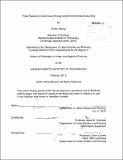Three papers on input-ouput [sic] energy and environmental accounting
Author(s)
Huang, Sonya (Sonya Y.)
DownloadFull printable version (16.07Mb)
Alternative title
Three papers on input-output energy and environmental accounting
Other Contributors
Massachusetts Institute of Technology. Department of Urban Studies and Planning.
Advisor
Karen R. Polenske.
Terms of use
Metadata
Show full item recordAbstract
The input-output model, a framework for national accounting and economic modeling, has been popular among regional economists for studying energy and emissions due to its focus on interindustry linkages. In a series of three papers, we apply the input-output model to three different aspects of fossil-fuel energy consumption and carbon dioxide emissions, using two temporally extensive datasets. In the first paper, we construct detailed energy and emissions accounts of the United States from 1972 to 2002, and analyze the resulting time series from perspectives of household consumption and industrial production. The resulting accounts suggest that despite an overall decrease in energy intensity over the study period, the decrease was uneven across industry sectors and consumption goods, especially between manufacturing and services. In the second paper, we perform a structural decomposition of CO² emissions growth in 36 countries over the years 1995-2009, using a newly published dataset. We compare the relative contributions to emissions growth from industrial efficiency improvements, interindustry linkage structure, and final demand levels and composition. We find that industrial efficiency and final demand predictably work against each other, but which effect dominates depends on geographic region. Analysis of specific energy-intensive industries sheds more light on the reasons for the geographic variation in emissions growth. In the third paper, we focus on embodied CO² emissions in trade, using the same dataset as the second paper. Predictably, countries in the European Union tend to import more embodied emissions than they export, while large developing countries such as China, Russia, and India export more than they import. However, we find more nuanced trends in resource-rich developed countries including the United States, Canada, Mexico, and Australia. In particular, the United States became a net exporter of embodied CO² emissions only recently, which may mean that the relevance of the topic of emissions abatement responsibility to the United States has shifted in recent years.
Description
Thesis (Ph. D.)--Massachusetts Institute of Technology, Dept. of Urban Studies and Planning, 2013. CD contains files with numerous source codes. Cataloged from PDF version of thesis. Includes bibliographical references (p. 159-170).
Date issued
2013Department
Massachusetts Institute of Technology. Department of Urban Studies and PlanningPublisher
Massachusetts Institute of Technology
Keywords
Urban Studies and Planning.